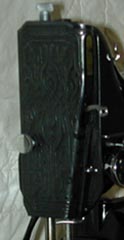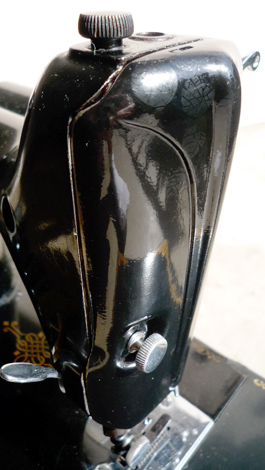
Darla Trenner, has researched and designed a wonderful website about the Singer Crinkle and Blackside Sewing Machines. (Including the 221 machines.) Her site is no longer available. I've listed her research here for your insight and knowledge.
What is a Blackside 221?
Manufactured before and after WWII when chromium and nickel were difficult to  come by, the Featherweight Blackside machine has a japan finish and gold decals identical to the Standard 221 but its faceplate is not plated like the standard machine, it is coated black.The coating provides a dull, non-reflective finish.
come by, the Featherweight Blackside machine has a japan finish and gold decals identical to the Standard 221 but its faceplate is not plated like the standard machine, it is coated black.The coating provides a dull, non-reflective finish.
 come by, the Featherweight Blackside machine has a japan finish and gold decals identical to the Standard 221 but its faceplate is not plated like the standard machine, it is coated black.The coating provides a dull, non-reflective finish.
come by, the Featherweight Blackside machine has a japan finish and gold decals identical to the Standard 221 but its faceplate is not plated like the standard machine, it is coated black.The coating provides a dull, non-reflective finish.
In an effort to determine the method Singer used to blacken parts, I am gathering information on the passivation and phosphating processes used during the time of 221 blackside production. If you have information which may aid the search.
Although the handwheel rim on the majority of reported Featherweight 221's prior to AG818000 is silver, the handwheel rim on all reported blackside machines is the shiny black japan finish.

Additionally, the backplate on the stitch length regulator is solid black (with the exception of the stitch length markings) on all reported blackside machines.
The presser foot lifter bar on reported blackside machines is predominantly shiny black instead of silver.
There are currently two identified production runs that contain Featherweight 221 blackside machines—July 1, 1941 and September 19, 1945. The serial numbers of blackside 221 machines are not consecutive , they are intermixed with standard machines in the production runs.
, they are intermixed with standard machines in the production runs.
There are also non-blackside Featherweight machines in the two known production runs that have a black presser foot lifter bar and non-blackside machines with a solid black stitch length regulator backplate. , they are intermixed with standard machines in the production runs.
, they are intermixed with standard machines in the production runs.After more than 50 years it is likely that these machines are not in 'original' condition—parts break, become misplaced, and get replaced. It is unknown whether all blackside 221 machines originally included a black presser foot lifter bar, bobbin case, bobbins, presser feet, or accessories... and it probably will never be known.
Machines documented as blackside 221's in the database coincide with a known blackside 221 production run, have a black scroll faceplate, and have a black handwheel rim.
The Featherweight 221 was not the only blackside model Singer produced and not the first; in the AF and AG series alone there are model 66, 99, and 128 machines with black coated faceplates, presser feet, and accessories. All parts on the blackside machines are standard, the finish is simply different.
Urban Legend: 221 Blackside with a Black Pressed Steel Faceplate
In the book "Featherweight 221 - The Perfect Portable" by Nancy Johnson-Srebro, the author states that a 221 machine from the November 22, 1946 production run—AG883740—has a black pressed steel faceplate, much like the faceplates used on the 221K white and 221J tan machines and a teardrop-shaped faceplate retaining screw.
221K white and 221J tan faceplates are easily identified; they have a slot approximately 1/4" long and 1/16" wide at the very top of the faceplate that is used to locate a supporting screwhead. Additionally, 16 standard Featherweights with serial numbers ranging from AE to AM have been reported with repainted or stripped and plated 221K or 221J faceplates.
The database contains 489 other model 221 machines from the November 22, 1946 production run, all of which are standard machines.In September of 2009 a similar machine was sold on an Internet auction site for $341.67 plus shipping.
Both the seller and buyer granted permission to use their pictures on this website. This machine is from the September 16, 1946 production run—AG811471.
The database contains 426 other model 221 machines from the September 16, 1946 production run, all of which are standard machines.After viewing the pictures my observations are:
- The paint on the faceplate has what appears to be spiderwebbing indicative of spray painting rather than a baked on finish.
- There appear to be file marks on the edges of the casting where the faceplate is mounted.
- The faceplate fits poorly.
- The screwhead is not centered in the receiving slot and has damage marks from the tool used when it was removed or installed.
 |  |  |
Standard Faceplate
|
Blackside Scroll Faceplate
|
221K White Faceplate
|
After the convention Graham contacted me indicating that Danielle/Rachel "failed to show for the appointment to hand the machine over to Lloyd for transport to Charlotte and hasn't been heard from since."
In October of 2009, the new owner listed the machine on the same Internet auction site with an initial opening bid of $1,999 and buy-it-now of $2,500; the listing was continuously renewed through May of 2010 with the opening bid as low as $799 and as high as $1,925.
Then on May 7, 2010, the machine was listed as a 7-day auction with an opening bid of $0.99 and no reserve. The revised ad stated the machine was evaluated by an unnamed expert who concluded the faceplate was from a 1960's 221J.
The machine sold on May 14, 2010, for $401.01 plus shipping.
Concerning the teardrop-shaped screw:
After studying the picture of this machine on page 72 of the 1997 edition of "Featherweight 221 - The Perfect Portable", a member of Featherweight Fanatics pointed out that any Featherweight 221 can appear to have a teardrop-shaped screw by raising the presser foot lifter bar and simulating the angle at which the picture was taken. On page 204 of the 2001 edition of her book, Ms. Srebro retracted the statements in earlier editions regarding the teardrop-shaped screw.
http://home.roadrunner.com/~featherweight/
What is a Crinkle 221?
Unlike the shiny japan finish on the Standard Featherweight 221, the bed of the Featherweight 221 crinkle machine has a dull textured finish and three parallel grooves cut into the perimeter. Its faceplate is either the standard plated striated faceplate that was introduced on Featherweights during the AH serial number series in 1947 or a plain black faceplate with three vertical grooves down the center.
machine has a dull textured finish and three parallel grooves cut into the perimeter. Its faceplate is either the standard plated striated faceplate that was introduced on Featherweights during the AH serial number series in 1947 or a plain black faceplate with three vertical grooves down the center.
 machine has a dull textured finish and three parallel grooves cut into the perimeter. Its faceplate is either the standard plated striated faceplate that was introduced on Featherweights during the AH serial number series in 1947 or a plain black faceplate with three vertical grooves down the center.
machine has a dull textured finish and three parallel grooves cut into the perimeter. Its faceplate is either the standard plated striated faceplate that was introduced on Featherweights during the AH serial number series in 1947 or a plain black faceplate with three vertical grooves down the center.
We may never know the true origin of the Featherweight 221 crinkle machine, but what is known is that Singer produced other models with a crinkle finish: models 66, 99, and 128 well before the 221 crinkle machine was manufactured.
 | However, none of these models had grooves cut into their beds like the crinkle Featherweight 221.At the time, the Featherweight 221 was Singer's most produced and most popular model; the grooves may have been added as a simple decoration. |
Where I could not convince clerks to dig through the documentation, I pulled in favors from friends living and visiting all over the U.S. who have generously given their time to look through mounds of military documents, maritime museum archives, the National Archives and Records historical documents, records of war production, Lend/Lease Administration archives, War Production Board archives, Office of Price Administration archives, Department of Justice Federal Prison Industries, Federal Property Utilization Branch of the Treasury Department, Purchase and Contract branch, etc.
This research encompassed the years 1930 through 1950.
Through these efforts, I have documentation of military contracts for Singer models 241, 17, 97, 68, 69, 144, and class 7 (model 31) but no branch of the armed services has produced a contract or purchase order for a Singer model 221.
There are
 currently two identified production runs of Singer Featherweight 221 crinkle machines—December 5th, 1939 and August 15th, 1940. The serial numbers of crinkle 221 machines currently appear to be consecutive in the first production run and intermixed with japan-finished machines in the second production run.
currently two identified production runs of Singer Featherweight 221 crinkle machines—December 5th, 1939 and August 15th, 1940. The serial numbers of crinkle 221 machines currently appear to be consecutive in the first production run and intermixed with japan-finished machines in the second production run.The faceplates on all reported 221 crinkle machines in the first run—December 5th, 1939—are black with three parallel grooves like the grooves on the bed.
The faceplates on reported 221 crinkle machines in the second run—August 15th, 1940—are a mix of the black grooved faceplate and the plated striated faceplate that was introduced on Featherweights during the AH serial number series in 1947.
 |  |  |
Standard Faceplate
|
Crinkle Plain Faceplate
|
Striated Faceplate
|







No comments:
Post a Comment